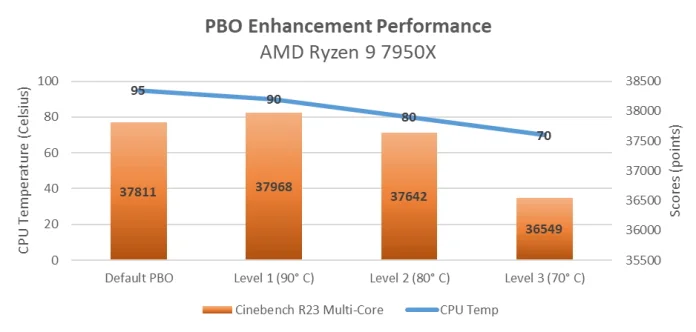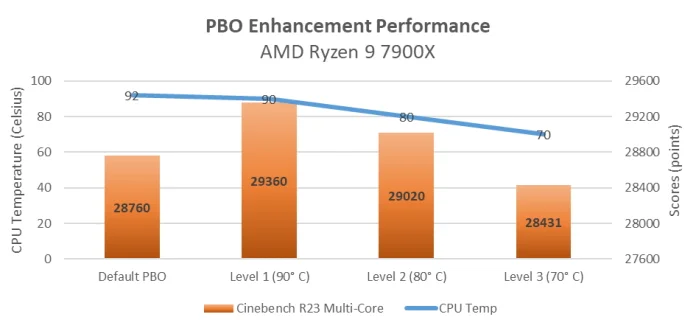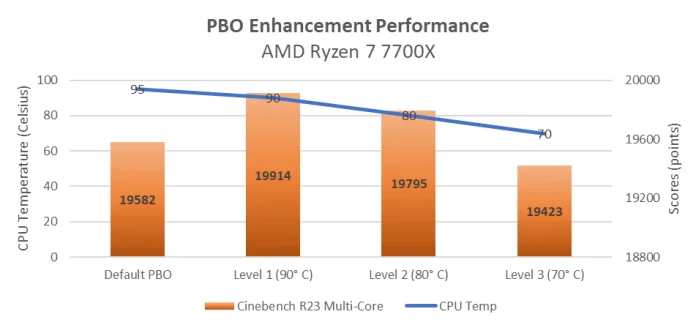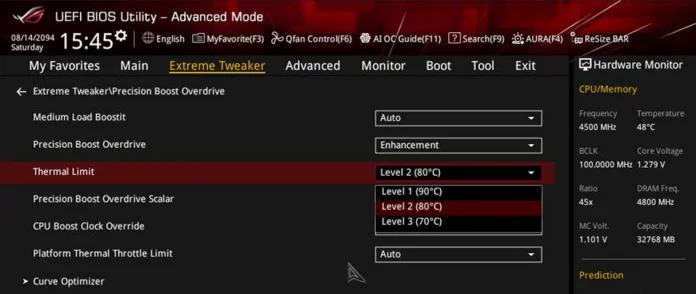It has been a couple of months since AMD's Ryzen 7000 series processors launched, and we've had some time to test the newest additions to our test system - the Ryzen 7 7700X, ASUS ROG STRIX B650E-F GAMING WiFi, and the Corsair Vengeance DDR5 32 GB kit with AMD EXPO.
A lot was made around the launch about the temperatures of these 7000 series processors, along with their efficiency, or lack thereof. AMD designed these processors for a temperature target of 95 degrees Celsius. The voltages and frequency are designed for this level of temperature in order to squeeze out every bit of performance when all cores under full load in heavy multi-core scenarios. AMD guarantees that these temperatures are safe, and that the CPUs have self-imposed limits that will prevent them from hitting harmful temps. Having said that, there are people who are uncomfortable with such high temps, whether it's because they have sub-optimal cooling solutions or they simply want to reduce the power draw of their processor in general. Enter, PBO Enhancement from ASUS - an ASUS exclusive feature aimed at making Ryzen 7000 CPUs more efficient.
The video below showcases how well this setting works at lowering temperatures and power draw in gaming without sacrificing performance. The games are tested at 1080p.
Test System
➤ RTX 3080 Ti
➤ Ryzen 7 7700X
➤ 32 GB Corsair Vengeance DDR5 with AMD EXPO
➤ ADATA XPG SX8200 Pro NVMe SSD 1 TB
➤ Seasonic Focus GX-1000
➤ Arctic Freezer 34 CO
➤ Phanteks Eclipse P500A DRGB
To quote ASUS,
To put you in control, we’re rolling out a BIOS update for our X670 and B650 motherboards with new options for our PBO Enhancement feature that make it easy for you to balance thermals and performance. With just a few clicks, you’ll be able to dramatically lower your CPU temperatures—and maybe even increase performance and reduce fan noise in the process.
They go on to say,
with this PBO Enhancement setting, you’re not only setting a temperature limit, you’re activating voltage and PBO optimizations
ASUS provides performance metrics from multi-core Cinebench tests for all four Zen4 processors tested at stock, and all three PBO Enhancement levels - Level 1 (90C target), Level 2 (80C target), and Level 3 (70C target.)




These multi-core Cinebench numbers are consistent with our testing. Using our Ryzen 7 7700X, we gathered additional temperature and voltage data from HWInfo64 while running the multi-core Cinebench test.
At stock settings:

Level 1 (90C):

Level 2 (80C):

Level 3 (70C):

You can see the different PPT/EDC/TDC values for each level compared to stock settings. Additionally, when we compared a manually set thermal limit of 80C to PBO Enhancement Level 2 (80C), Level 2 of the PBO Enhancement had a reduced voltage compared to the manually set thermal limit. This supports the claims made by the company that this feature has voltage optimizations that allow it operate at lower temperatures and draw less power, while maintaining performance, or in some cases, even increase it!
Our gaming results from the video above are interesting as well. While you are unlikely to hit the 95C thermal limit, or 140W of power, in a gaming environment, PBO Enhancement still does an exemplary job of lowering CPU temps by up to 10 degrees or more at times, and reducing power consumption, without any hit to performance. In fact, Level 3 (70C) actually sees slight gains in most games we have tested.
To activate this feature on your ASUS motherboard, update to the latest BIOS firmware. Then, enter the BIOS, head over to the Extreme/AI Tweaker tab, select Precision Boost Overdrive, and from the dropdown menu select 'Enhancement.' From there, you can choose the thermal limit you wish.

This is a very impressive feature from ASUS that sets them apart from the competition. Every motherboard, including those from ASUS, support Eco mode, but from what we have seen, PBO Enhancement seems to do a much better job of maintaining pace with stock settings in terms of performance, and even increasing it in certain scenarios. We're looking forward to seeing how this feature evolves over time with future BIOS updates, and whether or not other manufacturers will design similar solutions.
Stay in touch with Compusemble
Visit our YouTube channel for all your tech and gaming content needs and follow us on Twitter.